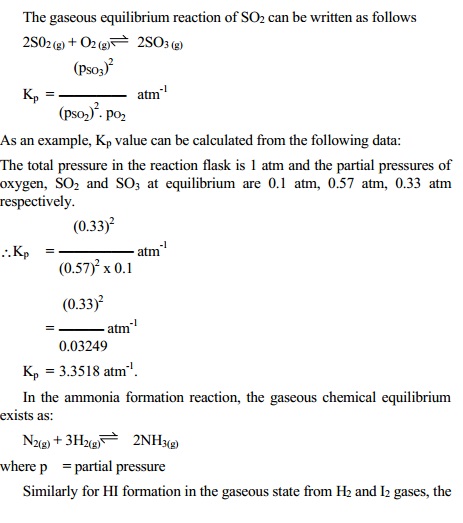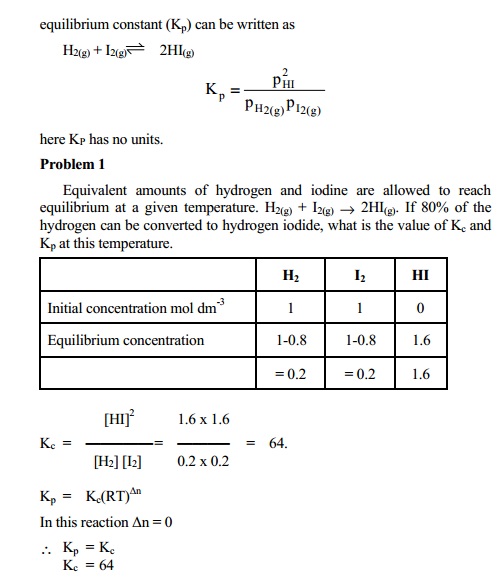Chapter: 11th 12th std standard Class Organic Inorganic Physical Chemistry Higher secondary school College Notes
Law of chemical equilibrium and equilibrium constant with example
Law of chemical equilibrium and equilibrium constant
Law of Mass action
Two Norwegian Chemists, Guldberg and Waage,
studied experimentally a large number of equilibrium reactions. In 1864, they
postulated a generalisation called the Law
of Mass action. It states that:
"the rate of a chemical reaction is proportional to the active
masses of the reactants". By the term `active mass', it is meant the molar
concentration i.e., number of moles per litre.
Law of Mass Action based on the Molecular
Collision theory
We assume that a chemical reaction occurs as the
result of the collisions between the reacting molecules. Although some of these
collisions are ineffective, the chemical change produced is proportional to the
number of collisions actually taking place. Thus at a fixed temperature the
rate of a reaction is determined by the number of collisions between the
reactant molecules present in unit volume and hence its concentration, which is
generally referred as the active mass.
Equilibrium constant and equilibrium law
Let us
consider a general reaction
A + B - - Kf --- > < ---Kr---
C + D
and let [A], [B], [C] and [D] represent the molar concentrations of
A,B,C and D at the equilibrium point. According to the Law of Mass action,
Rate of
forward reaction a[A][B] = Kf[A][B]
Rate of
forward reaction a[C][D] = Kr[C][D]
where kf
and kr are rate constants for the forward and reverse reactions.
At equilibrium, rate of forward reaction = rate of reverse reaction.
Therefore,
kf[A]
[B] = kr
[C] [D]
kf / kr = [C] [D] / [A] [B]
At any specific temperature kf/kr is a constant since both kf and kr are
constants. The ratio kf/kr is called equilibrium
constant and is represented by the symbol Kc. The subscript `c' indicates
that the value is in terms of concentration of reactants and products. The
equation (1) may be written as
Kf (Equilibrium
constant) = [C] [D] (Products concentration) / [A] [B] (Reactants concentrations)
This equation is known as the equilibrium
constant expression or equilibrium law. Hence [C], [D] [A] and [B] values are
the equilibrium concentrations and are equal to equilibrium concentrations.
Equilibrium Constant
Expression for a Reaction in General Terms
The general reaction may be written as
aA + bB -- > < -- cC + dD.
where
a,b,c and d are numerical quotients of the substance A,B,C and D respectively.
The equilibrium constant expression is
Kc = [C]c [D]d / [A]a [B]b
where Kc is the Equilibrium constant. The general definition
of the equilibrium constant may thus be stated as :
The product of the equilibrium
concentrations of the products divided by the product of the equilibrium
concentrations of the reactants, with each concentration term raised to a power
equal to the coefficient of the substance in the balanced equation.
For Example
(a) Consider the equilibrium constant expression for the reaction
N2(g) + 3H2(g) -- > < -- 2NH3 (g)
1.
The equation is already balanced. The numerical
quotient of H2 is 3 and NH3 is 2.
2.
The concentration of the `product' NH3 is [NH3]2.
3.
The product of concentrations of the reactants
is [N2] [H2]3.
4.
Therefore, the equilibrium constant expression
is
Kc = [NH3]2
/ [N2] [H2]3
(b) Consider the equilibrium constant expression for the reaction
N2O5 (g)--
> <
-- NO2(g) + O2 (g)
1.
The equation as written is not balanced.
Balancing yields
2N2O5 -- > < -- 4NO2 + O2.
2.
The coefficient of the product NO2 is
4 and of the reactant N2O5 is 2.
3.
The product of the concentrations of products is
[NO2]4 [O2].
4.
The concentration of the reactant is [N2O5]2
5.
The equilibrium constant expression can be
written as
Kc = [NO2]4 [O2]
/ [N2O5]2
(c) Consider the equilibrium constant expression of the reaction.
CH4(g) + H2O(g) CO(g) + 3H2(g)
1.
Write the product of concentrations of
`products' divided by the product (multiplication) of concentrations of
`reactants'.
2.
The concentration of H2 is to be
raised by its coefficient in the balanced equation. Thus, the equilibrium
constant expression is :
Kc = [CO] [H2]3 / [CH4] [H2O]
When all the reactants and products are gases, we can formulate the
equilibrium constant expression in terms of partial pressures exactly similar
to equation (1).
The partial pressure of a gas in the equilibrium mixture is directly
proportional to its molar concentration at a given temperature.
K p = pc pd / PjAPkB
The
gaseous equilibrium reaction of SO2 can be written as follows
2S02
(g) + O2 (g) --- > < -- 2SO3
(g)
Kp = (PSO3)2 / (PSO2)2. PO2 atm-1
As an
example, Kp value can be calculated from the following data:
The total pressure in the reaction flask is 1 atm and the partial
pressures of oxygen, SO2 and SO3 at equilibrium are 0.1
atm, 0.57 atm, 0.33 atm respectively.


Related Topics